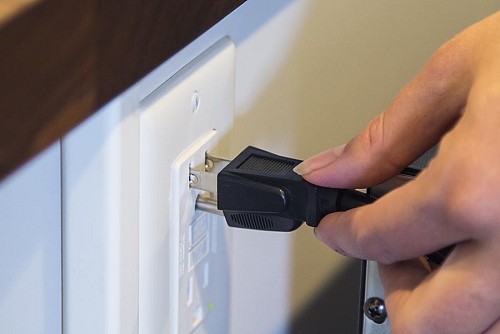Electrical Outlet Not Working? How To Troubleshoot
 One of life’s little annoyances is when you find an electrical outlet not working. But bothersome as it may seem, a non-functioning electrical outlet is actually fairly simple to deal with. Troubleshoot your electrical receptacle with the help of our handy list. Ah, if only all of life’s annoyances were so easily taken care of!
One of life’s little annoyances is when you find an electrical outlet not working. But bothersome as it may seem, a non-functioning electrical outlet is actually fairly simple to deal with. Troubleshoot your electrical receptacle with the help of our handy list. Ah, if only all of life’s annoyances were so easily taken care of!
FOR YOUR SAFETY: Do-it-yourself electrical repair is extremely hazardous and can cause shock, fire, or electrocution, not to mention possibly voiding your homeowners coverage for any property damage that results. Hire a licensed electrician if you are not 110 percent sure of what you're doing.
If you do attempt DIY electrical work, first turn off the main power and use an accurate non-contact voltage tester to double check that your electrical wiring is not “hot.”
Test the appliance.
Although your problem may initially seem to be the electrical outlet not working, the appliance (or lamp, tool, electronic device, etc.) you’re trying to use could actually be the trouble source.
Press the reset button, if the appliance has one. Inspect the appliance’s plug and cord to verify that they are in good shape, and make sure the plug is firmly inserted in the socket.
Next, try connecting to another outlet. If your device switches on successfully, you’ve confirmed that the first electrical outlet is not working.Check the breaker.
Go to your electrical service panel (or fuse box, in an older home), which may be located in your basement, garage, or hallway, or on an outside wall. If a breaker has tripped or a fuse is blown, reset the breaker or replace the fuse. If it looks like nothing’s wrong – or one or more breakers is only partially tripped -- try flipping each individual breaker off and then on again, to make sure they all snap properly back into place.Check the GFCI outlet.
Building code requires installation of a GFCI outlet (Ground Fault Circuit Interrupter) in any area of your home where there is a faucet or other water source – kitchen, bath, laundry room, garage, or outdoors.
Designed to protect users against potentially fatal electrical shock, this type of outlet is super sensitive and will trip in response to a power surge or even excessive humidity. It may then affect outlets in other parts of the house.
Make sure that there is no water in contact with your GFCI outlet before pressing the “Reset” button. Occasionally a GFCI outlet will not reset. This is a serious problem that needs the attention of a licensed electrician.Inspect the electrical outlet.
Inspect the electrical outlet itself. Scorch marks, buzzing and sizzling sounds, or excessive heat when you place your hand near (not on) the outlet are flashing red lights, telling you to call in an expert.
If none of these danger signals is present, you might want to use a voltage tester to see whether the outlet is not working itself.
A defective electrical outlet is relatively inexpensive to replace; consider upgrading to a tamperproof or GFCI outlet or installing a duplex outlet in place of a single.Check the connection to your electrical wiring.
Could it be that the electrical outlet has been dead since you moved into your home? If so, there’s a distinct possibility that it was never properly connected to your electrical wiring. Alternatively, the wires may have become loose or corroded over time.
In either case, the connecting wires must be cleaned and reattached so that the electrical outlet not working currently (apologies for the pun!) will finally be usable.
Laura Firszt writes for networx.com.
Updated September 6, 2018.
Looking for a Pro? Call us (866) 441-6648

Average Costs
Related Experiences

Electrical Upgrade Including New Breakers And Replacement Wiring

Pool Wiring Repair Eliminates A Potential Hazard



